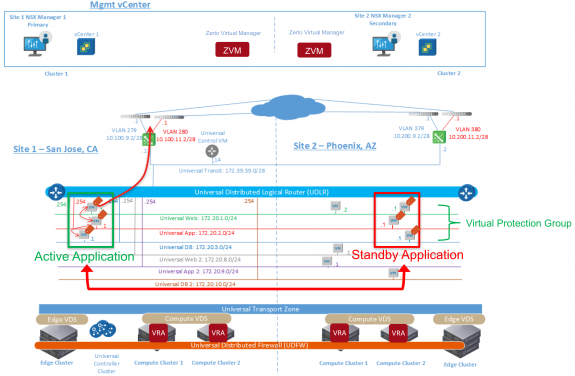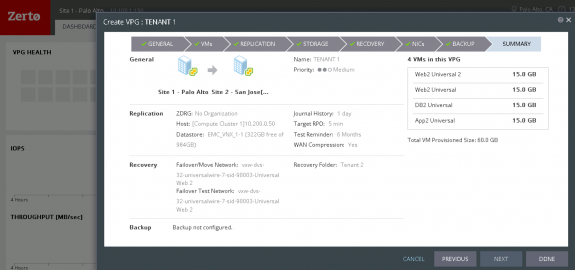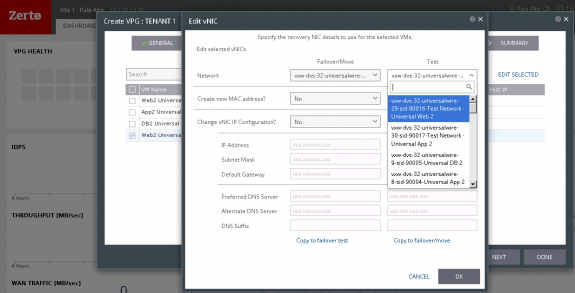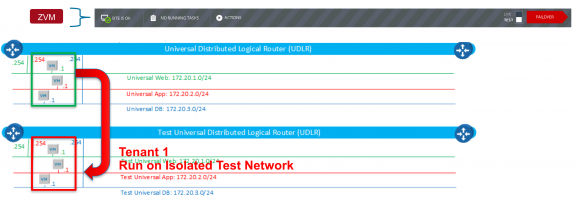
VMware NSX and Zerto - Testing DR Plan
In a few prior blogs I posted on this site and on the VMware Network Virtualization blog site, I described and demoed how VMware NSX and SRM with vSphere Replication combined provide for an enhanced disaster recovery (DR) solution. SRM also provides additional integration with NSX when Storage Policy Protection Groups (SPPGs) are used by providing the ability to automate network mappings. One of the great things about the NSX-V platform, is it can be used with any DR orchestration tool that supports the VMware vSphere ESXi hypervisor. Some of the tools customers are using with NSX include VMware SRM, Dell EMC RP4VM, Zerto, and Veeam. As SRM was discussed and demonstrated in a prior blog, Zerto and NSX together is explained in more detail below.
Prior Blogs:
Enhanced Disaster Recovery with Cross-VC NSX and SRM
VMware NSX and SRM: A Better Disaster Recovery Solution
VMware NSX and SRM: Disaster Recovery Overview and Demo [Video]
For more details on Disaster Recovery with NSX, make sure to check-out the Disaster Recovery Solutions with NSX [NET1188BU] session at upcoming VMworld 2017 on August 28th. I will discuss DR with NSX and DR Orchestration tools (SRM, RP4VM, and Zerto) in more detail. Justin Giardin from iland will discuss how they use NSX and Zerto to provide DRaaS solutions. Additionally, Ian Allie from Dell EMC Enterprise Hybrid Cloud (EHC) will discuss how they use NSX and RP4VM to provide DR services for their customers.
Similar to vSphere Replication, Zerto provides the ability to replicate workloads at the VM-level. Zerto Virtual Manager (ZVM) is a standalone manager installed on a Windows workstation. The diagram below shows how ZVM is deployed within the management vCenter domain in a multisite Cross-VC NSX environment.
Once the ZVM is linked to the respective vCenter, a user can log-on ZVM using vSphere credentials. From the ZVM a Zerto Virtual Replication Appliance (VRA) can be installed on the desired hosts that have VMs that need to be protected.
In Figure 3, it can be seen that there are four VMs in the Zerto Virtual Protection Group (VPG) being replicated/protected.
Similar to what was shown prior with SRM, Zerto can also ensure when a application or site failure event occurs the application(s) are recovered on the same network thanks to NSX logical networks spanning both sites and vCenter domains. In addition to the consistent networking across sites/vCenters, consistent security also exists. Thus, the end result is better recovery time objective (RTO) for applications as the IP address for the application does not need to change and security policies do not have to be manually replicated.
Figure 4 below shows how the default network mapping is configured within ZVM. By default, all workloads will failover to the respective default Failover Network upon actual failover and respective Failover Test Network when testing the Zerto DR plan.
As Figure 5 shows, different Failover Networks and Failover Test Networks can also be configured for each specific VM.
An extremely valuable capability of leveraging NSX with DR Orchestration tools like SRM, RP4VM, and Zerto is the capability to test the DR plan without any disruption to the production network. NSX enables this by allowing for isolated test logical networks to be created easily with the same IP addressing scheme. The DR orchestration tools can then be configured to use the isolated test networks for realistic DR Plan testing. This is represented in the below diagram using Zerto.
As mentioned prior, for more details on Disaster Recovery with NSX and DR orchestration tools like SRM, RP4VM, and Zerto, make sure to check-out the Disaster Recovery Solutions with NSX [NET1188BU] session at upcoming VMworld 2017 on August 28th.
Follow me on Twitter: @Humair_Ahmed









 Twitter
Twitter LinkedIn
LinkedIn Youtube
Youtube RSS
RSS